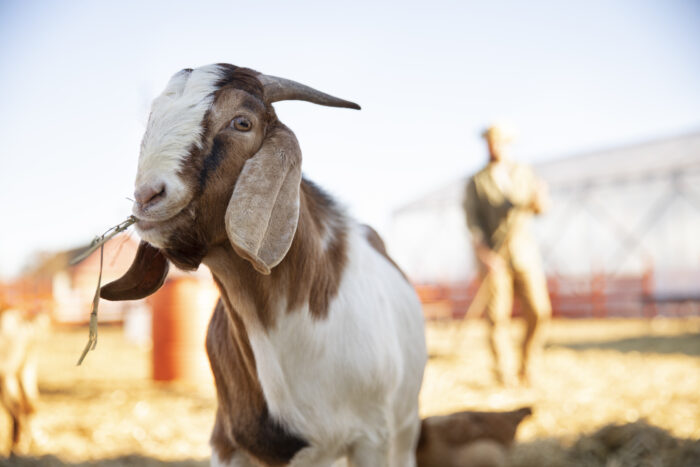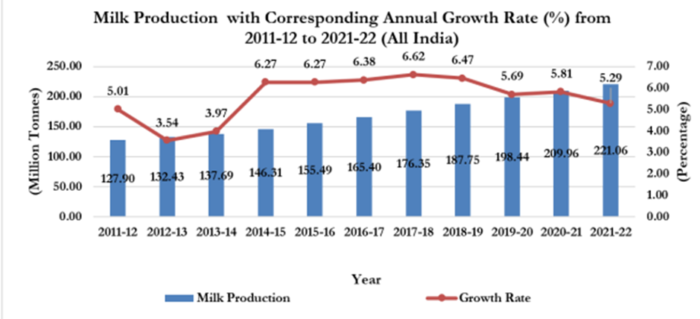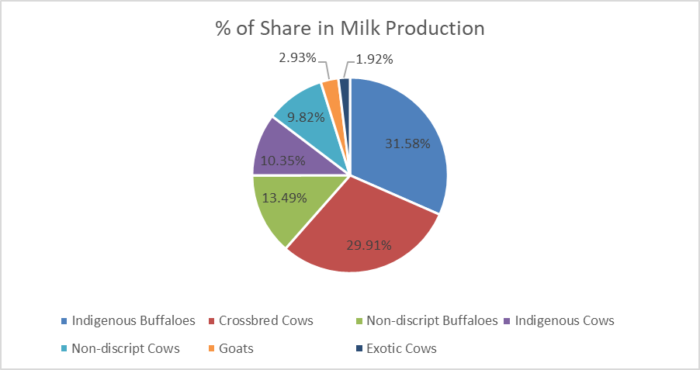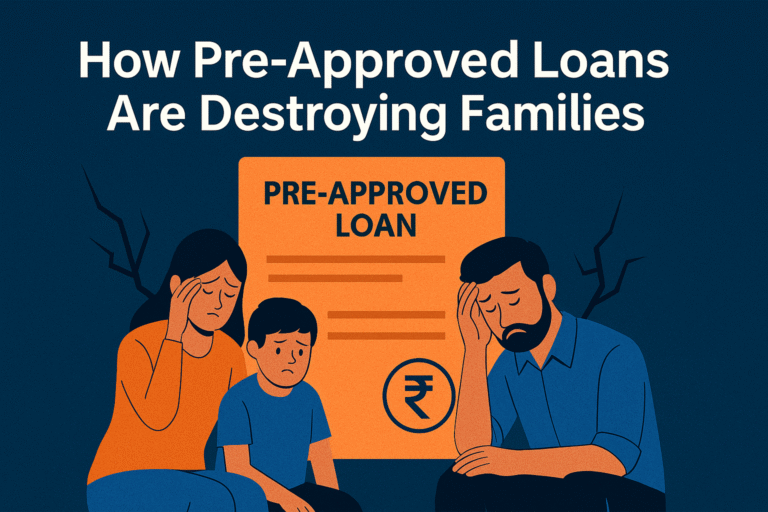Table of Contents
Introduction-Goat Farming
In the heart of rural India, goats play a vital role, offering more than just milk and meat—they bring economic possibilities and sustainable agriculture to the forefront. Our project report on Goat Farming isn’t a dry collection of facts; instead, it’s a friendly companion, ready to walk you through the ins and outs of goat farming.
We’re your guides through this journey, exploring everything from selecting the right goat breeds to practical tips on health care. Our goal is to equip you with practical knowledge and innovative ideas that resonate with the realities of goat farming in India.
Engaging in goat farming proves to be a lucrative venture, with its promising economic potential drawing increasing attention in both intensive and semi-intensive systems for commercial production over the past couple of years. The prospect of financial gains has fueled the rising momentum behind goat rearing as a viable and rewarding business endeavor.

The current favorable market conditions and the widespread availability of advanced goat technologies are increasingly drawing the interest of entrepreneurs. This has led to the establishment of numerous commercial goat farms in various regions across the country.
Diverse goat varieties are available, with some primarily suitable for milk production and others specifically bred for meat. The versatility of goats allows for farming in relatively small pasture areas, making it feasible even with limited resources.
So, let’s embark on this adventure together, discovering the joys and challenges of “Bharatiya Bakri.” Every page is an invitation to understand the unique story each goat tells and the potential each hoofprint holds. Join us as we celebrate the world of goat farming—a world where simplicity meets sustainability, and where every effort contributes to a thriving future. Welcome to the journey of goat farming in India!
Key Business Points
Embarking on a successful goat farming venture requires careful consideration of several crucial factors. Here’s a guide to help you lay the foundation for a thriving goat farming business:
Project Location:
Selecting the right location is paramount for the success of your goat farm. Optimal locations are often situated away from urban areas to shield the animals from potential harm caused by urban pollution. Accessibility to a consistent and nearby source of fresh grass, a staple in a goat’s diet, is essential to ensure their well-being.
Goat Breed:
The choice of goat breed is a pivotal decision, hinging on the purpose of your farming venture. Some breeds are renowned for higher milk production, while others are bred for rapid growth, suitable for meat production. Consider your goals and, if feasible, explore farming both types to harvest both meat and milk.
Proper Nutrition:
Goats are discerning eaters, and providing them with a clean and abundant supply of fresh grass is crucial. As herbivores, their diet primarily consists of grasses, plants, shrubs, weeds, and herbs. To promote their growth and well-being, it’s imperative to ensure they receive the necessary nutrients, including energy, vitamins, fiber, and water.
Housing:
Constructing low-cost and efficient housing is essential for the well-being of your goats. Elevated platforms, about one meter from the ground, can be made using bamboo/wooden poles or more permanent structures with concrete pillars. Adequate floor space, proper ventilation, and a drainage system are critical. Keep the living space clean, dry, and well-ventilated to promote a healthy environment for your goats.
Veterinarian Aid:
Access to a qualified veterinarian is indispensable for disease control and overall herd health. Diseases can pose a significant threat to your animals, and a veterinarian can help with disease prevention, diagnosis, and recommend necessary supplements to maintain good health, especially during stress-inducing situations like weaning.
Vaccination:
Protecting your goats against prevalent diseases is a crucial aspect of goat farming. Vaccinations for viral diseases like PPR, goat pox, foot and mouth diseases, as well as bacterial diseases like anthrax and brucellosis, are essential. Ensure timely and proper vaccination to prevent outbreaks and maintain the health of your herd. By carefully considering these factors, you pave the way for a successful and sustainable goat farming venture.
Exploring Profitable Goat Breeds for Successful Farming
Below, we highlight the top 10 goat breeds that can serve as a solid foundation for a lucrative commercial goat farming venture.
1. Boer Goat Farming:
- Originating in South Africa, Boer goats are globally renowned for their rapid growth, adaptability, and resistance to heat and diseases.
- Well-suited for meat production, Boer goats thrive in demand due to their impressive weight gain, reaching up to 45 Kg.
2. Barbari Goat:
- Originally from Berbera, Somalia, Barbari goats have gained popularity in Indian conditions for their adaptability and appealing compact size.
- Ideal for meat production, Barbari goats are commonly found in India and Pakistan, with a mature weight of around 38 Kg for males and 23 Kg for females.
3. Malwa Goat:
- Originating in Madhya Pradesh, Malwa goats are predominantly reared for their high milk production capabilities.
- With a mature weight of around 50 Kg and a focus on quality feeding, Malwa goats offer an excellent choice for goat farming in India.
4. Sirohi Goat:
- Hailing from the Sirohi district of Rajasthan, these goats are highly adaptable and commonly found across various regions in the state.
- Ideal for breeding and meat production, Sirohi goats exhibit a small to medium-sized body, with a mature male weight of 50 Kg and females weighing 25 to 30 Kg.

5. Tellicherry Goat:
- Grown in Kerala and raised in Tamil Nadu, Tellicherry goats, also known as Malabari goats, are recognized for their high multiple birth rate.
- With a mature weight of 45 to 50 Kg for males and 35 to 40 Kg for females, Tellicherry goats are suitable for meat, skin, and milk production.
6. Black Bengal Goat:
- Prominently grown in West Bengal and Bangladesh, the Black Bengal goat is sought after for its delectable meat and nutritious milk.
- With a budget-friendly price, these goats weigh around 15 to 16 Kg for males and 12 Kg for females, making them an excellent choice for goat farming.
7. Jamunapari Goat:
- Originating in Uttar Pradesh, Jamunapari goats are prolific breeders ideal for profitable commercial goat farming.
- With a mature weight of 65 to 75 Kg for males and 45 to 60 Kg for females, they are sought after for their meat and milk production.
8. Osmanabadi Goat:
- Mainly grown in Maharashtra and parts of Andhra Pradesh, Osmanabadi goats are raised for meat and milk.
- With an adult male weight of 32 to 36 Kg and an adult female weight of 30 to 32 Kg, these goats contribute to a sustainable goat farming business.
9. Saanen Goat:
- Originating in the Saanen Valley of Switzerland, Saanen goats are prized for their high-quality milk production.
- Highly adaptable to cold regions, Saanen goats are an excellent choice for small-scale commercial goat farming.
10. Beetal Goat:
- Originating in Punjab and also raised in Pakistan, Beetal goats may be smaller in size but weigh impressively.
- With an adult male weight of 45 to 65 Kg and an adult female weight of 35 to 45 Kg, Beetal goats are versatile, suitable for both meat and milk production.
Choosing the right goat breed is a critical step in the journey of establishing a successful goat farming business. Consider your business requirements and goals to select the breed that aligns best with your aspirations.
Government Subsidy
Embarking on a goat farming business necessitates a considerable initial investment. Fortunately, the Government of India allocated a substantial amount, totalling Rs 1,24,000 crore in the financial budget 2022-23, dedicated to rural development and farmer welfare. This presents a valuable opportunity for prospective goat farmers to access financial support.
The process is straightforward – aspiring goat farmers can avail themselves of this support by applying for a loan through nationalized banks such as the State Bank of India and Bank of India, among others. It’s crucial to initiate the application process before the commencement of the financial year. The financial assistance comes in the form of a subsidy, facilitated by the National Bank for Agriculture and Rural Development (NABARD).
The core objective of the National Bank for Agriculture and Rural Development (NABARD) concerning the goat farming business revolves around providing crucial support to small and medium-scale farmers. The aim is to bolster livestock farming production, consequently leading to the creation of additional employment opportunities.
NABARD facilitates goat farming loans through collaboration with various financial institutions, including:
- Commercial Banks
- Regional Rural Banks
- State Cooperative Banks
- Urban Banks
- Other eligible financial entities for refinancing by NABARD
This strategic partnership ensures that aspiring goat farmers can access the necessary financial resources through a network of established institutions. By fostering collaboration with these entities, NABARD actively contributes to the growth and sustainability of goat farming while concurrently promoting economic development in rural areas.
The various state governments in India also provide subsidies for goat farming. All states in India have their own policy to provide subsidy for goat farming. Therefore, subsidy amount may vary based on selection of state in which you want to start business of goat farming. This financial provision aims to empower individuals venturing into goat farming, offering a practical avenue for obtaining the necessary funds and promoting sustainable rural development. By taking advantage of these opportunities, aspiring goat farmers can kickstart their ventures with the support needed to foster growth and success in the industry.
Milk Production
In the diverse tapestry of Indian agriculture, the emergence of goat milk production stands as a testament to both nutritional diversity and economic resilience. The significance of goat milk extends beyond its creamy texture and distinct flavor, reaching into the realms of health, livelihoods, and sustainable farming practices.
Several states across India have become key players in the flourishing goat milk industry. States like Maharashtra, Uttar Pradesh, and Rajasthan have seen a remarkable increase in the number of goat dairy farms. This diversification not only boosts the income of farmers but also contributes to the overall economic development of these regions. India continues to be the largest producer of milk in world. Several measures have been initiated by the Government to increase the productivity of livestock, which has resulted in increasing milk production significantly.
Milk production during 2020-21 and 2021-22 is 209.96 million tonnes and 221.06 million tonnes respectively showing an annual growth of 5.29%. The per capita availability of milk is around 444 grams/day in 2021-22. The production of milk and corresponding annual growth rate (%) per year from 2011-12 to 2021-22 is given below:

Indigenous buffaloes had the highest share of milk production in India with 31.58 percent in the fiscal year 2022. It was followed by crossbred cows accounting for over 29 percent of the total milk production in the country. Share of Goat Milk Production was around 2.93% in fiscal year 2022.

SWOT ANALYSIS
Strengths:
- Self-Employment Creation: Goat farming offers a pathway to self-employment, empowering individuals to become entrepreneurs.
- Self-Sustenance: Allows for the production of food for personal consumption, contributing to self-sufficiency.
- Low Labor Requirement: Compared to other farming ventures, goat farming requires minimal labor input.
- Low Initial Investment: The initial financial commitment for starting goat farming is relatively low.
- Disease Resistance: Goats exhibit robust health, showing resilience against various diseases.
Weaknesses:
- Manpower Shortage: Traditional goat farming systems face challenges due to a lack of sufficient manpower.
- Aging Farmer Population: The majority of farmers engaged in goat farming are aging, posing a demographic challenge.
- Animal Welfare Conditions: Concerns exist regarding the suboptimal welfare conditions of goats in some setups.
- Organized Farming Challenges: Large-scale, organized goat farming struggles to establish itself as a successful venture.
- High Kid Mortality: The mortality rate among goat kids is notably high, impacting overall productivity.
Opportunities:
- Consumer Confidence: Growing consumer confidence in goat products presents an opportunity for market expansion.
- Promotion of Healthy Lifestyle: Goat farming aligns with the trend towards healthier living, fostering opportunities for promotion.
- Robust Market for Goat Meat: A substantial and ready market exists for goat meat, providing lucrative prospects.
- Steadily Increasing Market Prices: The market price for goat products is confirmed to be on a consistent upward trend.
Threats:
- Increasing Goat Population: The expanding goat population, coupled with diminishing grazing lands according to government census data, poses a significant challenge.
- Low Social Value: The farming activity associated with goat farming is sometimes perceived with low social value, posing a potential threat to its sustained growth.
FINANCIAL ANALYSIS

Cost of Project and Means of Finance
| COST OF PROJECT AND MEANS OF FINANCE | |||
| Sr No. | Particular | Amount(Rs) | Amount(Rs) |
| (A) | Livestock (Does and Bucks) | 11,16,000.00 | |
| (B) | Shed Construction | ||
| Shed for Bucks | 22,800.00 | ||
| Shed for Does | 4,56,000.00 | ||
| Shed for Kids | 2,28,000.00 | 7,06,800.00 | |
| (C ) | Machinery & Equipments | ||
| Equipments for Feeding | 25,400.00 | ||
| Chaff Cutter | 22,000.00 | ||
| Other Equipments | 4,800.00 | 52,200.00 | |
| (D) | Working Capital Gap | 7,00,000.00 | |
| Total Cost of project | 25,75,000.00 | ||
| Means of Finance | |||
| (A) | Term Loan Bank | 15,00,000.00 | |
| (B) | Working Capital | 5,25,000.00 | |
| (C) | Own Contribution/ Quasai Capital | 5,50,000.00 | |
| Total Means of Finance | 25,75,000.00 | ||
Techno Economic Parameter
| TECHNO ECONOMIC PARAMETER | |||
| Sr No | Particular | Unit | Description |
| 1 | Type Of Business | Goat Farming | |
| 2 | Breed of Goat | Osmanabadi/Barbari | |
| 3 | No of Does (Female) | Number | 160 |
| 4 | No of Bucks (Male) | Number | 8 |
| 5 | Age of Maturity | Months | 44905 |
| 6 | Kidding Interval | Months | 8 |
| 7 | No of Kidding | Per Year | 1.5 |
| 8 | Kidding Percentage | % | 80 |
| 9 | Average litter size (average of single, twinning, triplet, quadruplet) | 2 | |
| 10 | Sex Ratio | 1 : 1 | |
| 11 | Mortality Rate of Kids | % | 15 |
| 12 | Salable age of Kids | Months | 11 |
| COST PARAMETER | |||
| 1 | Space requirement per head for buck | Sq.ft | 15 |
| 2 | Space requirement per head for doe | Sq.ft | 15 |
| 3 | Space requirement per head for kid | Sq.ft | 5 |
| 4 | Cost of construction of shed for buck, doe & kid | Rs./Sq.ft | 190 |
| 5 | Cost of One Doe | Rs. | 6,500 |
| 6 | Cost of One Buck | Rs. | 9500 |
| 7 | Unskilled Labour | Number | 2 |
| 8 | Wages Per Month for Labour | Rs. | 7000 |
| 9 | Cost of one Chaff cutter | Rs. | 22,000 |
| 10 | Requirement of concentrate feed (adult animal/month) | Kg | 10.5 |
| 11 | Requirement of concentrate feed ( Kidd/month) | Kg | 5 |
| 12 | Rate of concentrate per Kg | Rs. | 20 |
| 13 | Misc.exp,(Vaccine, Medicine, and Veterinary aid/animal/year) | Rs. | 485 |
| 14 | Insurance | % | 5 |
| 15 | Electricity and water supply per month | Rs. | 1285 |
| No of Livestocks available for Sale | ||
| No of Kidding/Year | 2 | |
| No of Kids Born Male (Ratio 1 : 1) | 120 | |
| No of Kids Born FeMale (Ratio 1 : 1) | 120 | |
| No of Kids Died Male | 24 | |
| No of Kids Died FeMale | 24 | |
| No of Male Kids Avalilabel For Sale from Second Year | 96 | |
| No of FeMale Kids Avalilabel For Sale from Second Year | 96 | |
| Average Rate of Sale Male Goat | 14,500.00 | |
| Average Rate of Sale FeMale Goat | 12,500.00 |
Projected Income
| PROJECTED INCOME STATEMENT | ||||||
| A) | INCOME/EXPENSES | Ist Year | IInd Year | IIIrd Year | IVth Year | Vth Year |
| Sale Realisation | ||||||
| Male Goats | 1,74,000.00 | 13,92,000.00 | 15,03,360.00 | 16,23,628.80 | 17,53,519.10 | |
| Female Goats | 1,50,000.00 | 12,00,000.00 | 12,60,000.00 | 13,23,000.00 | 13,89,150.00 | |
| Sale of Manure | 22,500.00 | 23,625.00 | 24,806.00 | 26,046.00 | 27,348.00 | |
| B) | Total Income | 3,46,500.00 | 26,15,625.00 | 27,88,166.00 | 29,72,674.80 | 31,70,017.10 |
| C) | Cost of Sale | |||||
| Cost of Cattle Feed | 4,23,360.00 | 6,62,256.00 | 7,28,482.00 | 8,01,330.00 | 8,81,463.00 | |
| Wages & Salary | 1,50,000.00 | 3,15,000.00 | 3,30,750.00 | 3,47,288.00 | 3,64,652.00 | |
| Electricity | 15,420.00 | 16,191.00 | 17,001.00 | 17,851.00 | 18,744.00 | |
| Depreciation | 78,510.00 | 70,268.00 | 62,908.00 | 56,335.00 | 50,460.00 | |
| D) | Total Cost OF Sale | 6,67,290.00 | 10,63,715.00 | 11,39,141.00 | 12,22,804.00 | 13,15,319.00 |
| E) | Gross Profit(B-D) | (3,20,790.00) | 15,51,910.00 | 16,49,025.00 | 17,49,870.80 | 18,54,698.10 |
| Medical Expenses | 81,480.00 | 85,554.00 | 89,832.00 | 94,324.00 | 99,040.00 | |
| Repair | 1,044.00 | 1,096.00 | 1,151.00 | 1,209.00 | 1,269.00 | |
| Insurance Premium | 55,800.00 | 55,800.00 | 55,800.00 | 55,800.00 | 55,800.00 | |
| Telephone Expenses | 5,400.00 | 6,600.00 | 6,900.00 | 7,200.00 | 7,800.00 | |
| Administrative Expenses | 25,988.00 | 91,547.00 | 97,586.00 | 1,04,044.00 | 1,10,951.00 | |
| F) | Profit Before Intt& tax | (4,34,702.00) | 13,11,313.00 | 13,97,756.00 | 14,87,293.80 | 15,79,838.10 |
| Interest on term Loan | 1,80,000.00 | 1,63,278.00 | 1,23,870.00 | 79,463.00 | 29,425.00 | |
| Interest on WC Loan | 65,625.00 | 65,625.00 | 65,625.00 | 65,625.00 | 65,625.00 | |
| G) | Profit After Intt Before Tax | (6,80,327.00) | 10,82,410.00 | 12,08,261.00 | 13,42,205.80 | 14,84,788.10 |
| Less : Income tax | – | 2,81,427.00 | 3,14,148.00 | 3,48,974.00 | 3,86,045.00 | |
| H) | Profit Trf to Capital | (6,80,327.00) | 8,00,983.00 | 8,94,113.00 | 9,93,231.80 | 10,98,743.10 |
| NET PROFIT RATIO (%) | -196.34 | 30.62 | 32.07 | 33.41 | 34.66 | |
Projected Balance Sheet
| PROJECTED BALANCE SHEET | |||||
| LIABILITIES | Ist Year | IInd Year | IIIrd Year | IVth Year | Vth Year |
| Capital | 5,50,000.00 | 5,50,000.00 | 5,50,000.00 | 5,50,000.00 | 5,50,000.00 |
| Profit & LossA/c | (6,80,327.00) | 1,20,656.00 | 10,14,769.00 | 20,08,000.80 | 31,06,743.90 |
| Term Loan From Bank | 15,00,000.00 | 11,89,269.00 | 8,39,130.00 | 4,44,584.00 | 0.00 |
| Working Capital Loan | 5,25,000.00 | 5,25,000.00 | 5,25,000.00 | 5,25,000.00 | 5,25,000.00 |
| Provision for Income Tax | – | 2,81,427.00 | 3,14,148.00 | 3,48,974.00 | 3,86,045.00 |
| Sundry Creditors | 57,336.00 | 97,726.00 | 1,05,923.00 | 1,14,862.00 | 1,24,612.00 |
| Total | 19,52,009.00 | 27,64,078.00 | 33,48,970.00 | 39,91,420.80 | 46,92,400.90 |
| ASSETS | |||||
| Live Stock | 11,16,000.00 | 11,16,000.00 | 11,16,000.00 | 11,16,000.00 | 11,16,000.00 |
| Fixed Assets less Dep | 6,80,490.00 | 6,10,222.00 | 5,47,314.00 | 4,90,979.00 | 4,40,519.00 |
| Investments | 70,000.00 | 4,60,000.00 | 9,85,000.00 | 15,80,000.00 | 21,75,000.00 |
| Current Assets | ` | ||||
| Cattle Feed | 11,760.00 | 18,396.00 | 20,236.00 | 22,259.00 | 24,485.00 |
| Debtors | 28,875.00 | 2,17,969.00 | 2,32,347.00 | 2,47,723.00 | 2,64,168.00 |
| Other Current Assets | 18,250.00 | 2,12,506.00 | 3,09,568.00 | 3,92,890.00 | 4,79,820.00 |
| Cash and Bank | 26,634.00 | 1,28,985.00 | 1,38,505.00 | 1,41,569.80 | 1,92,408.90 |
| Total | 19,52,009.00 | 27,64,078.00 | 33,48,970.00 | 39,91,420.80 | 46,92,400.90 |
Note: Note above financial analysis is based on assumptions. This data may vary according to the requirements of a person who wants to enter into business of Goat Farming.
If you want access of complete financial projection with ratio analysis and other information in excel then click here to order.




